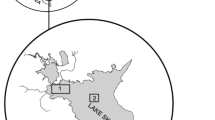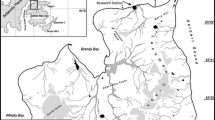Abstract
Several studies have demonstrated intraspecific variation in fish gill size that relates to variation in dissolved oxygen (DO) availability across habitats. In Lake Nabugabo, East Africa, ecological change over the past 12 years has coincided with a shift in the distribution of introduced Nile perch such that a larger proportion of the population now inhabits waters in or near wetland ecotones where DO is lower than in open waters of the lake. In this study, we compared gill size of juvenile Nile perch between wetland and exposed (open-water) habitats of Lake Nabugabo in 2007, as well as between Nile perch collected in 1996 and 2007. For Nile perch of Lake Nabugabo [<20 cm total length (TL)], there was a significant habitat effect on some gill traits. In general, fish from wetland habitats were characterized by a longer total gill filament length and average gill filament length than conspecifics from exposed habitats. Nile perch collected from wetland areas in 2007 had significantly larger gills (total gill filament length) than Nile perch collected in 1996, but there was no difference detected between Nile perch collected from exposed sites in 2007 and conspecifics collected in 1996.


Similar content being viewed by others
References
Balirwa J (1998) Lake Victoria wetlands and the ecology of the Nile tilapia Oreochromis niloticus (L.). Dissertation, University of Wageningen
Balirwa JS, Chapman CJ, Chapman LJ, Cowx IG, Geheb K, Kaufman L, Lowe-McConnell RH, Seehausen O, Wanink JH, Welcomme RL, Witte F (2003) Biodiversity and fishery sustainability in the Lake Victoria basin: an unexpected marriage? Bioscience 53:703–715
Chapman LJ (2007) Morpho-physiological divergence across oxygen gradients in fishes. In: Fernandes MN, Rantin FT, Glass ML, Kapoor BG (eds) Fish respiration and the environment. Science Publish Inc, Enfield, pp 14–29
Chapman LJ, Liem KF (1995) Papyrus swamps and the respiratory ecology of Barbus neumayeri. Environ Biol Fish 44:183–197
Chapman LJ, Hulen K (2001) Implications of hypoxia on the brain size and gill surface area of mormyrid fishes. J Zool 254:461–472
Chapman LJ, McKenzie D (2009) Behavioral responses and ecological consequences. In: Richards JG, Farrel AP, Brauner CJ (eds) Hypoxia in fishes. Elsevier, San Diego, pp 26–77
Chapman LJ, Chapman CA, Chandler M (1996a) Wetland ecotones and refugia for endangered fishes. Biol Conserv 78:263–270
Chapman LJ, Chapman CA, Ogutu-Ohwayo R, Chandler M, Kaufman L, Keiter AE (1996b) Refugia for endangered fishes from an introduced predator in Lake Nabugabo, Uganda. Conserv Biol 10:554–561
Chapman LJ, Chapman CA, Brazeau D, McGlaughlin B, Jordan M (1999) Papyrus swamps and faunal diversification: geographical variation among populations of the African cyprinid Barbus neumayeri. J Fish Biol 54:310–327
Chapman LJ, Galis F, Shinn J (2000) Phenotypic plasticity and the possible role of genetic assimilation: hypoxia induced trade-offs in the morphological traits of an African cichlid. Ecol Lett 3:388–393
Chapman LJ, Chapman CA, Nordlie FG, Rosenberger AE (2002) Physiological refugia: swamps, hypoxia tolerance and maintenance of fish diversity in the Lake Victoria region. Comp Biochem Physiol, Part A 133:421–437
Chapman LJ, DeWitt TJ, Tzaneva VJ, Paterson J (2007) Interdemic variation in the gill morphology of a eurytopic African cichlid. In Proceedings of the 9th International Symposium of Fish Physiology, Toxicology and Water Quality, pp 209–225
Chapman LJ, Albert J, Galis F (2008) Developmental plasticity, genetic differentiation, and hypoxia-induced trade-offs in an African cichlid fish. The Open Evolution Journal 2:75–88
Fish GR (1956) Some aspects of respiration of six species of fish from Uganda. J Exp Biol 33:186–195
Hendry AP, Taylor EB (2004) How much of the variation in adaptive divergence can be explained by gene flow: an evaluation using lake-stream stickleback pairs. Evolution 58:2319–2331
Kaufman L (1992) Catastrophic change in species-rich freshwater ecosystems: the lessons of Lake Victoria. Bioscience 42:846–858
Kramer DL (1983) The evolutionary ecology of respiratory mode in fishes: an analysis based on the costs of breathing. Environ Biol Fish 9:145–158
Kramer DL (1987) Dissolved oxygen and fish behavior. Environ Biol Fish 18:81–92
Kramer DL, Manley D, Bourgeois R (1983) The effect of respiratory mode and oxygen concentration on the risk of aerial predation in fishes. Can J Zool 61:653–665
Langerhans RB, Chapman LJ, DeWitt TJ (2007) Complex phenotype-environment associations revealed in an East African cyprinid. J Evol Biol 20:1171–1181
McKinsey DM, Chapman LJ (1998) Dissolved oxygen and fish distribution in a Florida spring. Environ Biol Fish 53:211–233
McNeil DG, Closs GP (2007) Behavioral responses of a south-east Australian floodplain fish community to gradual hypoxia. Freshw Biol 52:412–420
Mnaya B, Wolanski E, Kiwango Y (2006) Papyrus wetlands a lunar modulated refuge for aquatic fauna. Wetland Ecology and Management 14:359–363
Nilsson GE, Östlund-Nilsson S (2004) Hypoxia in paradise: Widespread hypoxia tolerance in coral reef fishes. Proc R Soc Lond, B Biol Sci 271:S30–S33
Nilsson GE, Renshaw GMC (2004) Hypoxic survival strategies in two fishes: extreme anoxia tolerance in the North European crucian carp and natural hypoxic preconditioning in a coral-reef shark. J Exp Biol 207:3131–3139
Nilsson GE, Hobbs JP, Östlund-Nilsson S, Munday PL (2007) Hypoxia tolerance and air breathing ability correlate with habitat preference in coral-dwelling fishes. Coral Reefs 26:241–248
Paterson JA (2008) Response of an introduced aquatic predator, the Nile perch, to environmental change. Dissertation, McGill University
Paterson JA, Chapman LJ (2009) Fishing down and fishing hard: Ecological change in the Nile perch of Lake Nabugabo, Uganda. Ecol Freshw Fish 18:380–394
Reist JD (1985) An empirical evaluation of several univariate methods for size variation in morphometric data. Can J Zool 63:1429–1439
Robb T, Abrahams MV (2003) Variation in tolerance to hypoxia in a predator and prey species: an ecological advantage of being small? J Fish Biol 62:1067–1081
Rosenberger AE, Chapman LJ (2000) Respiratory characters of three haplochromine cichlids: implications for persistence in wetland refugia. J Fish Biol 57:483–501
Rutjes HA (2006) Phenotypic responses to lifelong hypoxia in cichlids. Ph.D. Dissertation, Leiden University
Schofield PJ (1997) Feeding ecology of the introduced Nile perch (Lates niloticus) in Lake Nabugabo, Uganda: Implications for conservation of the indigenous fauna. Dissertation, University of Florida
Schofield PJ, Chapman LJ (1999) Interactions between Nile perch, Lates niloticus, and other fishes in Lake Nabugabo. Environ Biol Fish 55:343–358
Schofield PJ, Chapman LJ (2000) Hypoxia tolerance of introduced Nile perch: implications for survival of indigenous fishes in the Lake Victoria basin. African Zoology 35:35–42
Seehausen OJ, Van Alphen JM, Witte F (1997a) Cichlid fish diversity threatened by eutrophication that curbs sexual selection. Science 277:1808–1811
Seehausen OF, Witte EF, Katunzi J, Smits S, Bouton N (1997b) Patterns of the remnant cichlid fauna in Southern Lake Victoria. Conserv Biol 11:890–904
Strauss SY, Lau JA, Carroll SP (2006) Evolutionary responses of natives to introduced species: what do introductions tell us about natural communities? Ecol Lett 9:357–374
Timmerman CM, Chapman LJ (2004) Hypoxia and interdemic variation in the sailfin molly (Poecilia latipinna). J Fish Biol 65:635–650
Tobler M, DeWitt TJ, Schlupp I, Garcia de León FJ, Herrmann R, Feulner PGD, Tiedemann R, Plath M (2008) Toxic hydrogen sulfide and dark caves: phenotypic and genetic divergence across two abiotic environmental gradients in Poecilia mexicana. Evolution 62:2643–2659
Wanink JH, Witte F (2000) Rapid morphological changes following niche shift in the zooplanktivorous cyprinid Rastrineobola argentea from Lake Victoria. Neth J Zool 50:365–372
Wanink JH, Kashindye JJ, Goudswaard PCK, Witte F (2001) Dwelling at the oxycline: does increased stratification provide a predation refugium for the Lake Victoria sardine Rastrineobola argentea? Freshw Biol 46:75–85
Witte FM, Welton M, Heemskerk I, Van Der Stap L, Ham C, Rutjes C, Wanink J (2008) Major morphological changes in a Lake Victoria cichlid fish within two decades. Biol J Linn Soc 94:41–52
Acknowledgments
We thank Judy Dumont for her assistance in dissecting and photographing the gills of Nile perch. Permission for this project was granted by the Uganda National Council for Science and Technology. We also thank C.A. Chapman, D. Twinomugisha and Lake Nabugabo field assistants for assistance with field collections in Uganda. Funding for this research was provided by NSERC Discovery Grant and Canada Research Chair funds to L.J. Chapman.
Author information
Authors and Affiliations
Corresponding author
Rights and permissions
About this article
Cite this article
Paterson, J.A., Chapman, L.J. & Schofield, P.J. Intraspecific variation in gill morphology of juvenile Nile perch, Lates niloticus, in Lake Nabugabo, Uganda. Environ Biol Fish 88, 97–104 (2010). https://doi.org/10.1007/s10641-010-9600-6
Received:
Accepted:
Published:
Issue Date:
DOI: https://doi.org/10.1007/s10641-010-9600-6




